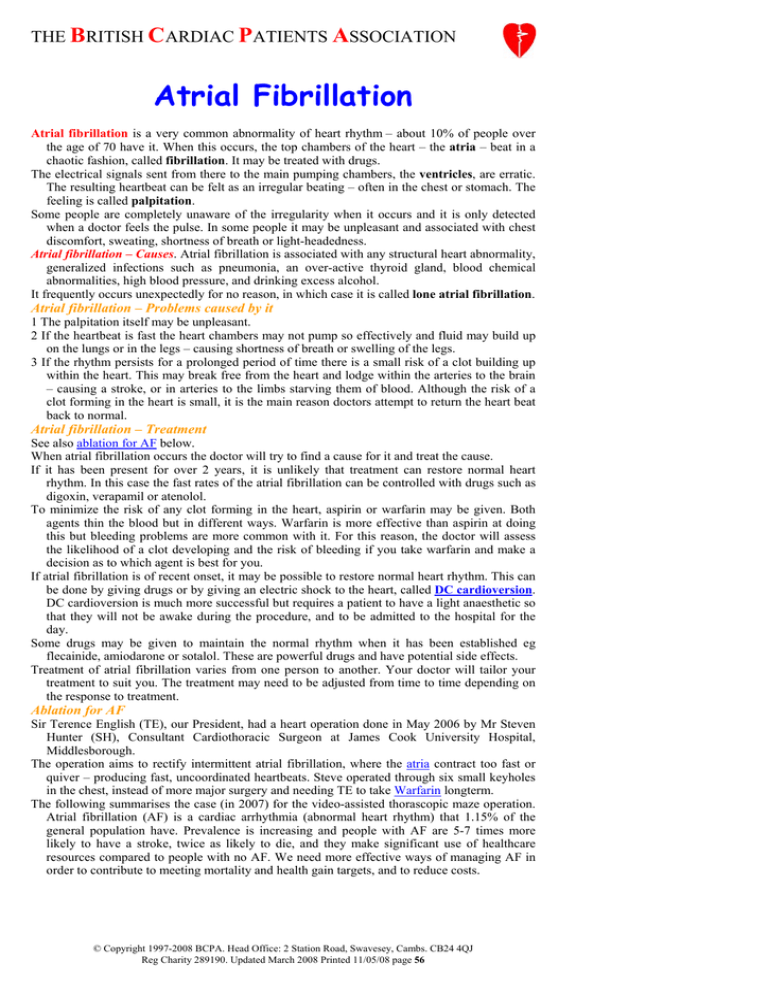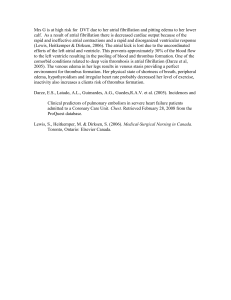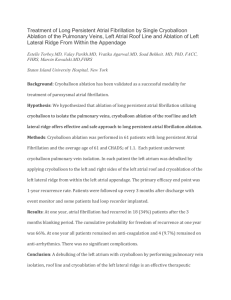
THE BRITISH CARDIAC PATIENTS ASSOCIATION
Atrial Fibrillation
Atrial fibrillation is a very common abnormality of heart rhythm – about 10% of people over
the age of 70 have it. When this occurs, the top chambers of the heart – the atria – beat in a
chaotic fashion, called fibrillation. It may be treated with drugs.
The electrical signals sent from there to the main pumping chambers, the ventricles, are erratic.
The resulting heartbeat can be felt as an irregular beating – often in the chest or stomach. The
feeling is called palpitation.
Some people are completely unaware of the irregularity when it occurs and it is only detected
when a doctor feels the pulse. In some people it may be unpleasant and associated with chest
discomfort, sweating, shortness of breath or light-headedness.
Atrial fibrillation – Causes. Atrial fibrillation is associated with any structural heart abnormality,
generalized infections such as pneumonia, an over-active thyroid gland, blood chemical
abnormalities, high blood pressure, and drinking excess alcohol.
It frequently occurs unexpectedly for no reason, in which case it is called lone atrial fibrillation.
Atrial fibrillation – Problems caused by it
1 The palpitation itself may be unpleasant.
2 If the heartbeat is fast the heart chambers may not pump so effectively and fluid may build up
on the lungs or in the legs – causing shortness of breath or swelling of the legs.
3 If the rhythm persists for a prolonged period of time there is a small risk of a clot building up
within the heart. This may break free from the heart and lodge within the arteries to the brain
– causing a stroke, or in arteries to the limbs starving them of blood. Although the risk of a
clot forming in the heart is small, it is the main reason doctors attempt to return the heart beat
back to normal.
Atrial fibrillation – Treatment
See also ablation for AF below.
When atrial fibrillation occurs the doctor will try to find a cause for it and treat the cause.
If it has been present for over 2 years, it is unlikely that treatment can restore normal heart
rhythm. In this case the fast rates of the atrial fibrillation can be controlled with drugs such as
digoxin, verapamil or atenolol.
To minimize the risk of any clot forming in the heart, aspirin or warfarin may be given. Both
agents thin the blood but in different ways. Warfarin is more effective than aspirin at doing
this but bleeding problems are more common with it. For this reason, the doctor will assess
the likelihood of a clot developing and the risk of bleeding if you take warfarin and make a
decision as to which agent is best for you.
If atrial fibrillation is of recent onset, it may be possible to restore normal heart rhythm. This can
be done by giving drugs or by giving an electric shock to the heart, called DC cardioversion.
DC cardioversion is much more successful but requires a patient to have a light anaesthetic so
that they will not be awake during the procedure, and to be admitted to the hospital for the
day.
Some drugs may be given to maintain the normal rhythm when it has been established eg
flecainide, amiodarone or sotalol. These are powerful drugs and have potential side effects.
Treatment of atrial fibrillation varies from one person to another. Your doctor will tailor your
treatment to suit you. The treatment may need to be adjusted from time to time depending on
the response to treatment.
Ablation for AF
Sir Terence English (TE), our President, had a heart operation done in May 2006 by Mr Steven
Hunter (SH), Consultant Cardiothoracic Surgeon at James Cook University Hospital,
Middlesborough.
The operation aims to rectify intermittent atrial fibrillation, where the atria contract too fast or
quiver – producing fast, uncoordinated heartbeats. Steve operated through six small keyholes
in the chest, instead of more major surgery and needing TE to take Warfarin longterm.
The following summarises the case (in 2007) for the video-assisted thorascopic maze operation.
Atrial fibrillation (AF) is a cardiac arrhythmia (abnormal heart rhythm) that 1.15% of the
general population have. Prevalence is increasing and people with AF are 5-7 times more
likely to have a stroke, twice as likely to die, and they make significant use of healthcare
resources compared to people with no AF. We need more effective ways of managing AF in
order to contribute to meeting mortality and health gain targets, and to reduce costs.
© Copyright 1997-2008 BCPA. Head Office: 2 Station Road, Swavesey, Cambs. CB24 4QJ
Reg Charity 289190. Updated March 2008 Printed 11/05/08 page 56
Conservative treatment options for AF have inherent problems. Firstly, antiarrhythmic drugs do
not deliver much better rates of sinus rhythm than controls. Secondly, the drugs are associated
with a high level of toxicity and serious complications, so tolerance and uptake are poor.
Thirdly, the drugs efficacy reduces over time. Finally, for many patients drug management
becomes expensive when the duration of treatment; the cost of monitoring and treating
adverse effects of drugs; the costs of repeated cardioversions, A&E visits, and emergency
admissions are taken into account.
Ablation, ie modified Maze procedure for AF in conjunction with mitral valve repair, promises
to be better in meeting all the primary goals of treatment for AF. It reverses the risk factors
that cause atrial fibrillation – slowing the heart rate, preventing strokes, getting AF back to
normal heart rhythm, and preventing recurrence. Patients' response to treatment appears to last
over time – with low rates of reoccurrence and less dependence on pharmacological therapies.
Although concomitant surgery for AF will increase the cost of mitral valve repair above tariff,
the investment should be more than offset by predicted savings against drug costs,
admissions, defibrillation, and the incidence of repeat procedures. Patients undergoing
concomitant ablation have lower cost of care in both year one and in the first five years after
surgery than other invasive treatments.
First published in this form 2002, and updated 2005, 2007, 2008.
All rights reserved. No part of this work may be reproduced, stored in a retrieval system or
transmitted, in any form or by any means, without written permission from the BCPA Head
Office.
We give permission for copies to be stored and made within the BCPA and any UK hospital; and
these hospitals may give printed but not electronic copies to patients provided the source and
copyright is acknowledged on the copies – eg include the page footer.
© Copyright 1997-2008 BCPA. Head Office: 2 Station Road, Swavesey, Cambs. CB24 4QJ
Reg Charity 289190. Updated March 2008 Printed 11/05/08 page 57







